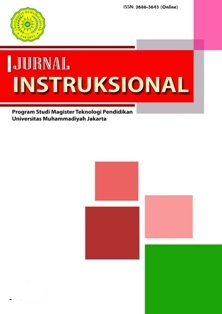PENGEMBANGAN DESAIN PEMBELAJARAN SISTEM BASIS DATA
Main Article Content
Abstract
Article Details
References
ACM, & Curricula, I. C. 2013. Computer Science Curricula 2013. ACM. https://doi.org/10.1145/2534860
Aditya, P. T. 2018. Pengembangan media pembelajaran matematika berbasis web pada materi lingkaran bagi siswa kelas VIII. Jurnal Matematika, Statistika dan Komputasi, 15(1), 64-74.
Anas, M., & Rosidhah, E. 2020. Pengembangan Inovasi Pembelajaran Ekonomi Mikro Dengan Model Addie. Seminar Nasional Manajemen, Ekonomi Dan Akuntasi Fakultas Ekonomi Dan Bisnis Unp Kediri, 265-273.
Aptikom, & KKNI, B. 2015. Naskah Akademik KKNI Rumpun Ilmu Informatika dan Komputer.
Branch, R. M., & Dousay, T. A. 2015. Survey of Instructional Design, Fifth Edition. Association For Educational Communication and Technology.
Carey, W. D., & Carey J, L. 2015. The Systematic Design of Instruction. Eighth Edition. Pearson.
Chen, C., & Tzeng, G. 2011. Expert Systems with Applications Creating the aspired intelligent assessment systems for teaching materials. Expert Systems With Applications, 38(10), 12168–12179. https://doi.org/10.1016/j.eswa.2011. 03.050
Chen, S. J. 2014. Instructional Design Strategies for Intensive Online Courses: An Objectivist-Constructivist Blended Approach. Journal of interactive online learning, 13(1), 72-85
Dewi, N. K. R. A., Jampel, I. N., & Agung, A. A. G. 2015. Pengembangan Multimedia Pembelajaran Interaktif IPA Dengan Model Assure Untuk Siswa Kelas VII SMP 1 Sawan. Jurnal Edutech Undiksha, 3(1): 1-11.
Farida, A., & Indah, R. P. 2019. Pengembangan Model Pembelajaran ARCS (Attention, Relevance, Confidence, Satisfaction) Dengan Wolfram Mathematica. Jurnal Derivat: Jurnal Matematika dan Pendidikan Matematika, 6(2), 47-53.
Gall, M. ., Gall, J. P., & Borg, W. R. 2007. Educational Research Eight Edition. Longman.
Gall, W. R. B. and M. D. 1983. Educational ResearchFourth Edition. New York: Longman.
Idris, A., & Rajuddin, M. 2012. The Trend of Engineering Education in Nigerian Tertiary Institutions of Learning towards Achieving Technological Development. 56(Ictlhe), 730–736. https://doi.org/10. 1016/j.sbspro.201 2.09.710
Jasmy, M., Rahman, A., Arif, M., Ismail, H., & Nasir, M. 2014. Development and Evaluation of the Effectiveness of Computer-Assisted Physics Instruction. 7(13), 14–22. https://doi.org/10.5539/ ies.v7n13p1 4
Joyce, B., Marsha, W., & Calhoun, E. (2009). Models of Teaching. EightEdition. Pearson.
Khalil, M. K., & Elkhider, I. A. 2016. Applying Learning Theories and Instructional Design Models for Effective Instruction. Advances in physiology education, 40(2), 147-156.
Rienties, B., Nguyen, Q., Holmes, W., & Reedy, K. 2017. A review of ten years of implementation and research in aligning learning design with learning analytics at the Open University UK. Interaction Design and Architecture(s), 33, 134–154.
Seels, B. B., & Rita C, R. 1994. Teknologi Pembelajaran: Definisi dan Kawasannya. Unit Percetakan UNJ.
Simamora, L., Hernaeny, U., & Safitri, N. D. 2020. Pengaruh Model Pembelajaran Attention, Relevance, Confidence, Satisfaction (ARCS) terhadap Kemampuan Pemecahan Masalah Matematika. JKPM (Jurnal Kajian Pendidikan Matematika), 5(2), 245-252.
Stracke, C. M. 2019. Quality Frameworks and Learning Design for Open Education. The International Review of Research in Open and Distributed Learning, 20(2): 180-203
Sugihartini, N., Agustini, K. 2017. Asesmen Otentik Sebagai Pendukung Desain Instruksional Jaringan Komputer Berstrategi Blended-Learning dengan Pendekatan Konstruktivistik. Journal of Education Research and Evaluation, 1(2), 82-90.
Suparman, M. A. 2014. Desain Instruksional Modern. Erlangga.
Tung, K. Y. 2017. Desain Instruksional. Andi.
Widoyoko, S. E. P. 2019. Evaluasi Program Pembelajaran (Panduan Praktis Bagi Pendididik Dan Calon Pendidik) (X). Pustaka Pelajar.
Yuanta, F. 2020. Pengembangan Media Video Pembelajaran Ilmu Pengetahuan Sosial pada Siswa Sekolah Dasar. Trapsila: Jurnal Pendidikan Dasar, 1(02), 91-100.
Yuelan, L., Yiwei, L., Yuyan, H., & Yuefan, L. 2011. Study on teaching methods of database application courses. Procedia Engineering, 15, 5425–5428.

